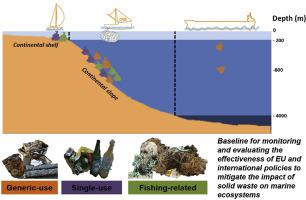Environmental Pollution ( IF 7.6 ) Pub Date : 2020-07-13 , DOI: 10.1016/j.envpol.2020.115213 G Garofalo 1 , F Quattrocchi 1 , G Bono 1 , M Di Lorenzo 1 , F Di Maio 2 , F Falsone 1 , V Gancitano 1 , M L Geraci 3 , V Lauria 1 , D Massi 1 , D Scannella 1 , A Titone 1 , F Fiorentino 1

|
Abundance, composition, and distribution of macro-litter found on the seafloor of the Strait of Sicily between 10 and 800 m depth has been studied using data collected by bottom trawl surveys MEDITS from 2015 to 2019. Three waste categories based on the items use were considered: single-use, fishing-related and generic-use. Over 600 sampling sites, just 14% of these were litter-free. The five-years average density of seafloor litter was 79.6 items/km2 and ranged between 46.8 in 2019 and 118.1 items/km2 in 2015. The predominant waste type was plastic (58% of all items). Regardless of material type, single-use items were a dominant (60% of items) and widespread (79% of hauls) fraction of litter with a mean density of 48.4 items/km2. Fishing-related items accounted for 12% of total litter items. Percentage of dirty hauls and litter density increased with depth. Analysis of the relation density-depth indicates a progressive increase of litter density beyond depth values situated within the interval 234–477 m depending on the litter category. A significant decrease in litter density by categories was observed over the period. Patterns of spatial distribution at the higher depths (200–80 0m) resulted stable over the years. Density hotspots of fishing-related items were found where the fishing activity that uses fish aggregating devices (FADs) is practised and in the proximity of rocky banks. Single-use and generic-use objects densities were greater on the seafloor along main maritime routes than other areas. Comparisons between the percentage of hauls littered with anthropic waste from the mid-1990s against those in 2018–19 highlighted an increase of about 12% and 15% for single-use items and fishing-related items respectively, and a decrease of 13% for generic-use items. This study provides a snapshot of the current situation of littering in the central Mediterranean Sea and represents a solid baseline against which the effectiveness of current and future mitigation strategies of the litter impact on marine environment can be measured.
中文翻译:

我们的海洋中有什么?在地中海中部海底评估人为垃圾。
根据2015年至2019年海底拖网调查MEDITS收集的数据,对在西西里海峡海底10至800 m深度海底发现的大量垃圾进行了研究。考虑:一次性使用,与捕鱼有关的用途和一般用途。超过600个采样点,其中只有14%是无垃圾的。五年的海底垃圾平均密度为79.6项/ km 2,介于2019年的46.8和2015年的118.1项/ km 2之间。主要的废物类型是塑料(占所有项目的58%)。无论材料类型如何,一次性垃圾占主要(占垃圾的60%),占垃圾的大部分(占拖运的79%),平均密度为48.4个/ km 2。与钓鱼有关的物品占垃圾总量的12%。脏料的百分比和垃圾密度随深度增加。对密度-深度关系的分析表明,随垫料类别的不同,垫料密度会逐渐增加,超出位于234-477 m区间内的深度值。在此期间,分类观察到的凋落物密度显着下降。这些年来,较高深度(200–80 0m)的空间分布格局稳定。在与鱼类聚集设备有关的捕鱼活动中以及在石滩附近发现了与捕鱼有关的物品的密度热点。主要海路沿线海底的一次性和通用物品密度高于其他地区。从1990年代中期到2018-19两年间,散布在人类垃圾中的拖运百分比在比较中显示,一次性物品和与捕鱼有关的物品分别增加了约12%和15%,而一次性物品减少了13%。通用物品。这项研究提供了地中海中部乱抛垃圾现状的快照,并代表了一个坚实的基准,可以据此来衡量当前和未来减轻乱抛垃圾对海洋环境的影响的策略的有效性。











































 京公网安备 11010802027423号
京公网安备 11010802027423号